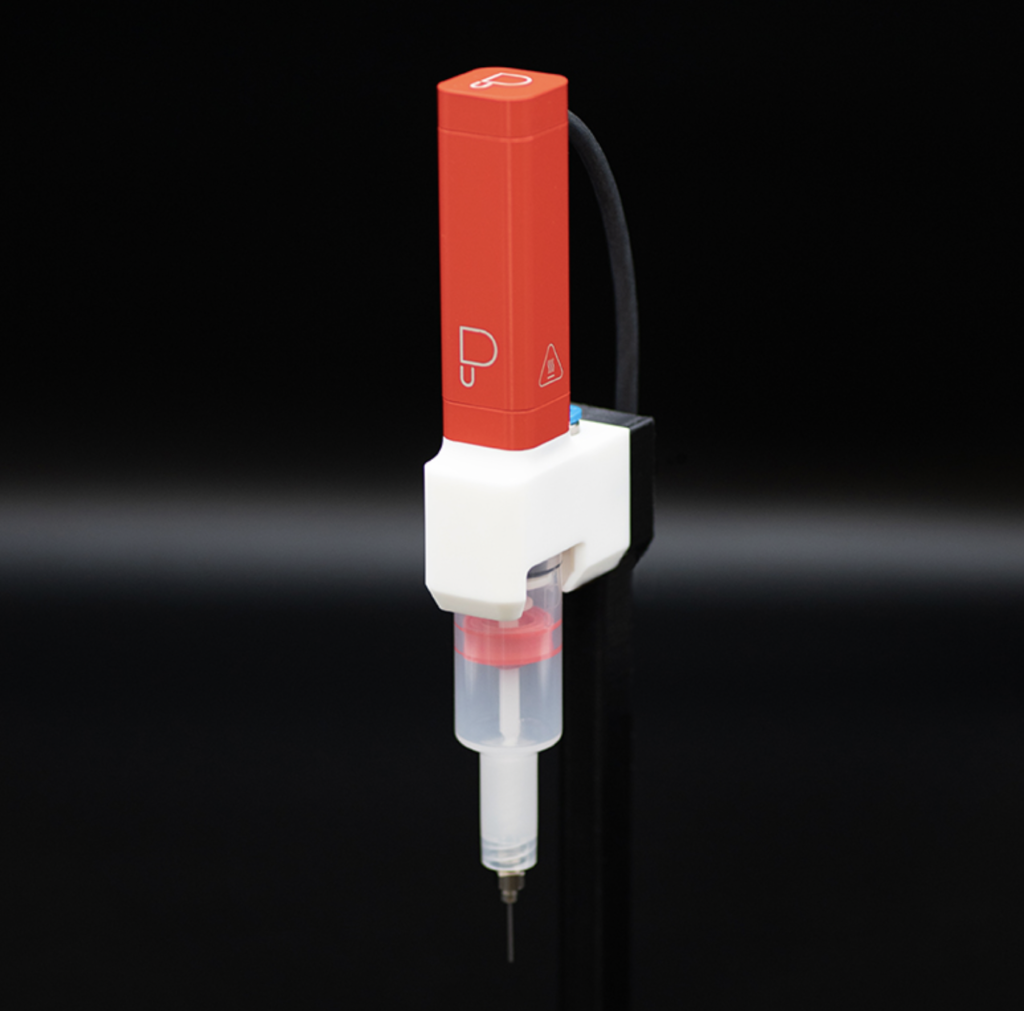German firm ViscoTec makes all manner of dispensing nozzles. For years they’ve been used in 3D printing to print silicone on standard material extrusion machines adapted to work with their nozzles. Now, the firm has developed nozzles under the Puredyne brand. The company´s Puredyne nozzles are single-use and meant to be used for the sterile, precise dispensing of cells for bioprinting.
If you want to use your Prusa i3 or Ultimaker for bioprinting, you’d typically have to adapt it to work with a complex air pressure driven pneumatic or piston-based system. Solutions such as piston driven syringes are quite popular with hobbyists extruding paste like materials, as well. However, Puredyne puts the complexity in the nozzle, giving you a simpler alternative. Puredyne nozzles have an endless piston in them. Essentially, this is a special rotating drill bit-style element that precisely doses many liquids continuously with regular pressure. The company claims 99% dosing consistency with such nozzles.
Puredyne nozzles are essentially a disposable, bioprinting-specific version of the more expensive ViscoTec nozzles. The same nozzles are now also being used for dispensing conductive inks. This allows bioprinting researchers to experiment with the intersection of electricity and cells by creating parts that send electrical signals to tissue.
The company claims that there is little-to-no dead space in the nozzle, little in the way of abrasion, and high precision as other advantages of ViscoTec’s approach. It also claims that “low-shear and pulsation-free dispensing results in a constant line width with a possible resolution below 200 µm.” The company has optimized its nozzles for pastes, conductive and ceramic materials, as well as alginate. Alginate and other bioinks can be loaded in through leak-proof connectors and dispensed precisely. The firm sees cosmetics, food printing, personalized medicine and organ models as possible verticals next to tissue engineering.

Precise paste and hydrogel extrusion has been a bit of a bugbear for 3D printing. I was originally inspired to get involved with additive manufacturing by a paper by Evan Malone and Hod Lipson showcasing how a syringe extruder could produce a very simple robot, body, actuators, batteries and all. This paper led to their development of the Fab@Home 3D printer in 2006. This was a complete desktop 3D printer that ended up being overtaken by the RepRap project. With Fab@Home, you could extrude all manner of pastes and the frontier was limitless. RepRap printers were far simpler and less expensive, however, so material extrusion with filament became predominant.
We’ve gained millions of inexpensive desktop 3D printers but we have lost the functionality to print circuits, batteries, actuators, two component materials, silicone and tissue at home. Therefore, I’m very excited by these Puredyne nozzles. I think that they could really help people print tissue and help a lot of labs go further with their current equipment. I can’t wait until everyone at home can use ViscoTec nozzles to make silicones, epoxies, circuits and tissues. I really think that the next frontier will be us moving into soft robotics and biological parts for 3D printing applications.
Subscribe to Our Email Newsletter
Stay up-to-date on all the latest news from the 3D printing industry and receive information and offers from third party vendors.
Print Services
Upload your 3D Models and get them printed quickly and efficiently.
You May Also Like
U.S. Navy Lab Uses 3D Printing to Reduce Tooling Lead Time By Over 90%
The F-35 Lightning II Joint Program Office (JPO), responsible for life-cycle management of the key fifth-generation joint strike fighter (JSF) system used by the U.S., its allies, and its partners,...
Etsy Design Rule Change Reduces Selection of 3D Printed Goods
Online marketplace Etsy has implemented a rule change requiring all 3D printed goods on the site to be original designs. The update to the site’s Creativity Standards states, ¨Items produced using...
Honeywell Qualifies 6K Additive’s Nickel 718 for 3D Printed Aerospace & Defense Parts
6K Additive is renowned for manufacturing sustainable additive manufacturing (AM) powder, and offers a wide portfolio of premium metal and alloy powders that include titanium, copper, stainless steel, and nickel,...
MetalWorm Sells WAAM Systems to Research Institutes in Brazil and Malaysia
Turkish WAAM firm MetalWorm has sold a system in Malaysia and another in Brazil. This is an excellent example of a few emerging trends in additive. Firstly, WAAM was experimented...

































